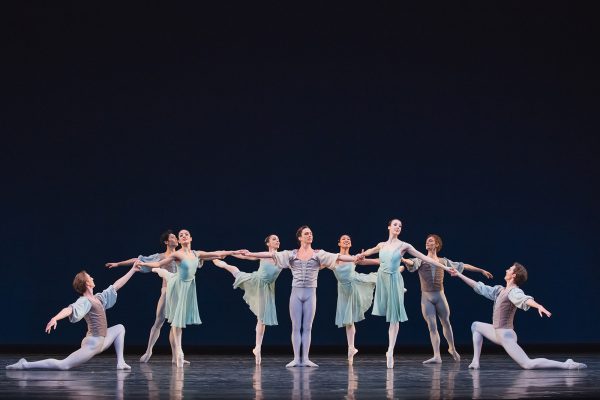Shannon Litzenberger’s HOMEbody: lessons in prairie living is a study in dance and landscape – a theme that seems to be cropping up all over the place at the moment. Full of evocative images of lives lived on the Saskatchewan prairies, Litzenberger pays homage to her past and present in an inventive and playful multimedia performance. Taken as a work of dance theatre the piece is very successful, combining text, film, narrative, music and movable set pieces to great effect. As a pure dance piece, however, Litzenberger misses the mark. There are a few sections of discernible “dancing” but they distract from what is otherwise a concept-driven work. Ultimately the lack of great dancing doesn’t matter due to the level of overall artistry attained in this one-woman show.
The stage is set with a crooked farm kitchen table that has a number of functions, including roles as a life raft carefully navigated across the stage on its top and a map of the province of Saskatchewan when turned on its side. The Winchester Street Theatre’s usual black drops were replaced with patchwork homespun quilts that billow gently as Litzenberger moves, like sheets hung to dry on the line. And, most striking, a wooden fence designed by Lindsay Ann Black that stretches to infinity along stage right. Sometimes it becomes an archetypal white picket fence (complete with gate) and later it’s the borderlines of her family’s farm that Litzenberger meticulously checks when walking the fence line. At the end of the piece Litzenberger dismantles the fence and hangs and lashes pieces of it from hooks suspended from the overhead lighting grid to build a house. The work grew out of Litzenberger’s desire to reconnect with and perform her sense of home. Through a series of residencies in her home town, personal research and contributions from collaborators, Litzenberger collected a range of stories, images and anecdotes that she then wove together to create a work that is at once personal to her and meaningful to all.
Exceedingly striking and clear video shot by Litzenberger herself and also by Jef Mallory was projected edge to edge on the back wall of the stage creating the sense of a limitless vista. Images of driving along flat, dusty roads that stretch on to the horizon, undulating wheat fields, a stand of trees at dusk, the approach to the Litzenberger farmhouse along a snowy, rutted driveway and the antics of gophers are poignant and timeless.
While the Litzenberger family farm is still functioning after nearly 100 years, owing to decreasing returns, the farms immediately adjacent to their land are not. One section of HOMEbody sees Litzenberger interacting with the filmed interior of one of the abandoned farms. The farm kitchen is in a state of suspended, post-apocalyptic disorder – cupboard doors flung open or off their hinges, drawers hanging, debris all over the linoleum floor, the glassless window above the sink letting in whirling snowflakes. The image has been enlarged so that Litzenberger appears the size of a two-year-old, bumping her head on the underside of one of the pulled-out drawers, carefully trying to pick her way around all the clutter. It is like one of those “after the storm had passed” moments when a child who has been hiding comes out to find everyone is gone — or worse. Though Litzenberger plays the scene innocently and with humour, it is chilling nonetheless.
Towards the end of the piece, videos of farmhouse basements — dark, forbidding and full of forlorn abandoned furniture, tools and rusty paint cans — make for a sad epilogue to the spirit of hope and warmth that Litzenberger expresses through most of the work.
In addition to ideas of home, Litzenberger returns again and again to numbers and counting. Voices count down the number of seconds to get to “home” as though playing hide and seek. They also list the street addresses of all the homes Litzenberger has had, the time it takes her to get from her vantage point on the roof down to the road to catch the school bus and the time that has elapsed since she first left the prairies at the age of 17. A voice-over describing how land in Saskatchewan was originally divided up into townships and then subdivided into parcels of farmland according to precise measurements makes the location of home seem arbitrary. At several points in the piece Litzenberger puts on different costume pieces – a sturdy pair of black overalls and a John Deere cap when she is working in the field, a gossamer-light emerald-green organza dress coat when she is reminiscing about times long past. At one point Litzenberger puts on “town” clothes — fitted suit jacket, clutch and high-heel shoes — to attend a job interview. The interview turns out to be a series of questions spoken by voice-over about what “home” means. The questions come at Litzenberger faster and faster, eventually overlapping as Litzenberger desperately tries to answer them, mutely using the contents of her purse. At first, the questions seem completely reasonable and thoughtful and Litzenberger does her best to respond. Yet, as the interview takes on the quality of a nightmarish cross-examination, the questions become ambiguous and impossible to answer. In the end, Litzenberger is overwhelmed and gives up, a fitting allegory for being unable to adequately put into words what home means.
There are many wistful, nostalgic moments in HOMEbody: Litzenberger sitting on the “porch” — created using pieces of the fence — listening to the crickets at the end of a day as the shadows lengthen. Recorded conversations with her dad about anachronistic machinery no longer in use. Images of swallow’s nests tucked into the eves of the roof. Lara’s Theme from the film Dr. Zhivago played on an out-of-tune piano while Litzenberger tells us about playing with a favourite uncle. At one point Litzenberger is standing upstage left in profile shivering with imagined cold. After a few moments a new image is projected and she is no longer the frozen teenager waiting for the bus but a wheat stalk trembling in the frigid air. “The light is different here,” Litzenberger reminds us. “The light seems to come from everywhere at once.” Litzenberger and her collaborators – especially director and creative consultant Marie-Josée Chartier and lighting designer Kimberly Purtell — are to be congratulated for the thoroughness of the piece, which was seamlessly executed and well-rehearsed. What struck me most was that, in the spirit of some kind of home-economics-inspired thrift, there is nothing extraneous or superfluous in HOMEbody. Every element of the work is used and explored to its inevitable conclusion. Not a moment, concept or set piece is wasted or cast adrift and all are tied together with the loose ends concealed. Simultaneously thoughtful and thought-provoking, HOMEbody holds together as a complete work.
Tagged: Contemporary, Performance, ON , Toronto





